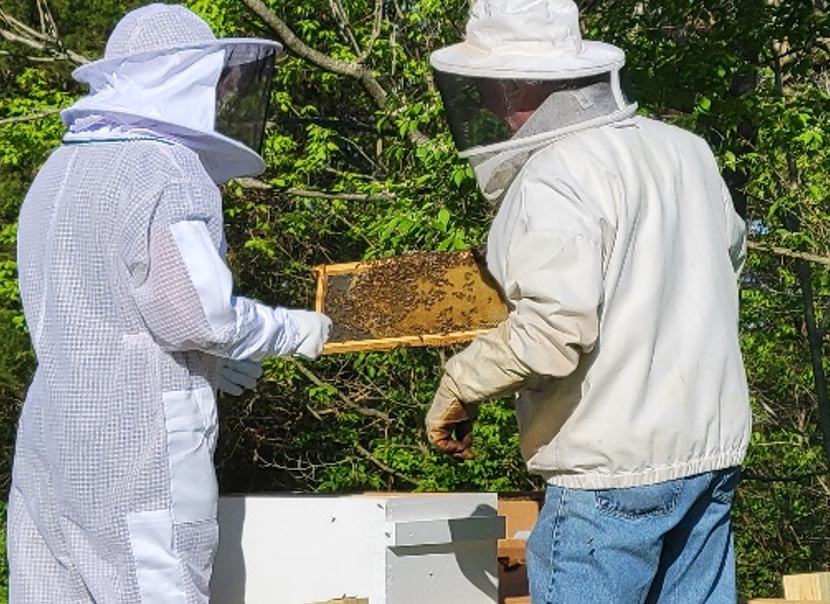Over the last 3 months I have experienced and learned many new things. April 18th, I received the nucleus colony from my local bee club along with the hive parts. The following day my mentor, Don Burkart, assisted me in transferring the frames into the 1st deep. I was nervous at first to handle the frames, the gloves are very bulky, I didn’t seem to have a good grip and was lacking in dexterity. Don showed me ways to hold and manipulate the frames as to not drop the frame or queen into grass and to prevent spilling nectar or pollen. This took me some time to get used to, but I can say I am making progress. The first colony consisted of 5 frames, 2 with capped/uncapped brood and 1.5 with nectar. I named the hive Alpha. We did notice 5 hive beetles and removed them. We did locate the queen; she was marked with a red dot. Over the next few days, it was interesting watching the bees do their work, defending a yellow jacket from the entrance, scout bees returning with yellow and orange pollen, and fanning.

A few days later I received a swarm colony from Don. They came in a deep with 5 frames. They next day I transferred the swarm into my second hive by myself. I made the decision to wear my nylon garden gloves for better handling. This was a mistake, as I got my first two stings to my right hand. I used a bee brush to help get the bees off the frame and that is when the stings occurred. I have not used a bee brush since. I was able to transfer the frames and majority of the colony into my second hive, Beta. I placed the empty deep in front to allow the remaining bees to fly into the hive. I inspected the hives about twice a week. After my third hive check and not able to locate the queen in the Beta, Don came over and helped locate her. Don using a queen trap, caught her and marked her. By the end of April, I had both hives together, 1 deep each. Trees in bloom on my property, lilac, honey suckles and black berry bushes.

It was interesting observing the bee’s behavior on the frames. Don informed me that generally if the queen is on the frame the bees are moving around more. I did notice this as I searched for the queen with each hive check. There is a difference between the nucleus (Alpha) and swarm (Beta) colonies. Beta progressed quickly to needing a second deep. The behavior of each colony was generally calm. I was amazed at how if you move slow and methodically the bee’s don’t mind you. Mid-May both colonies had good brood pattern with drone cells on the bottom. It was so neat to see a frame full of nectar on one side and capped/uncapped honey on the other. It’s amazing how small fresh laid eggs are. We did place hive beetle traps in each, only Alpha had beetles.

With one hive check there was a large black fuzzy spider living in the top board, as I was doing an inspection, I witnessed the spider attack and kill a bee. I promptly removed the spider. Alphas brood pattern started to become spotty, and still had 2 empty frames, while Beta was going strong, solid brood pattern and building comb out quickly in the second deep. By the end of May I added a honey super to Beta, second deep to Alpha and fed the bees sugar syrup with Harvest Lane Honey, Hive Stimulant added. I decreased hive inspections to just once a week in June. I read Mel Disselkoen book, OTS Queen Rearing which was very informative. I was conflicted about “dispatching” a queen. I understand now why beekeepers choose to replace the queen and why its good to do after the Summer Solstice. Alpha was already creating queen cups, which I was not surprised due the fact of the spotty brood pattern. I noted 17 queen cells with 3 capped queen cells. However, Beta was doing great, and I really did not want to remove the queen. I did remove her, as I was showing her to my daughter she flew away into the woods. I was surprised at how well she flew as people say queens don’t fly well.
With my last hive inspection 7/6/2024, the queen’s cells in Alpha were hatched but I did not see a queen. There was still capped brood, few capped drone cells, and no eggs. The second deep had 2 frames of honey, and the honey super had little comb built out. Beta has no capped queen cells, capped brood and drone cells, and no eggs. I am concerned I may be queen less in Beta, so I ordered an Italian Southern queen from Mann Lake. Hopefully with my next report I will have good news to share!



